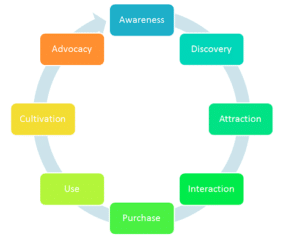It’s no secret that the future of energy lies in harnessing renewable sources, like solar, wind and energy storage. The recent IPCC report highlighted the urgency of the clean energy transition. For those of us involved in marketing clean energy and other climate solutions, our jobs just went from challenging…to critical.
How can you make your marketing efforts more effective when the planet’s clock is so relentlessly ticking?
What To Do
Setting the Right Goals
Perhaps it goes without saying, but we’ll say it anyway: Marketing goals should be specific, measurable and achievable — and carefully aligned with business objectives. Engage the management team in setting the goals. Talk with your sales team to understand what kind of help they need to support their efforts. At this stage you are listening more than talking.
The Customer Journey
Before setting down to doing the marketing work, take a beat to understand your customer’s journey. It can be tempting to skip this step in the interest of time, but don’t do it. If you do, you’ll only have to revisit the journey when your marketing efforts fall short.

According to the Content Marketing Institute, 50% of content created was intended to generate awareness and spark interest within this first step. Not surprisingly, this is where we find our first “do” on the list: content marketing.
Yes, Content is Still King
Content is still the cornerstone of digital marketing. In marketing clean energy, compelling content – with credible proof points, testimonials and highly evocative visuals – is the linchpin of an effective marketing plan.

Content of interest to your readers could be as simple as photos of the finished system or interviews that describe the customer’s journey to clean energy. All of these are grist for the content mill, to be shared through email marketing, social channels and more. Sharing these examples shows dedication to customer satisfaction and a willingness to constantly improve.
Email Marketing

For B2B companies, marketing emails are most effective when they feature original content that is informative and educational — and most of all, interesting. Good content is like a good story: It has an arc. For example, if you’re a solar company who sells to commercial businesses, customer case studies will be a key part of your content arsenal. Businesses need to see that other businesses, particularly those in their own industry, have successfully made the transition to renewables — and how.

Social Media: Is it Really Worth it?
One of the most frequent questions we get as a B2B marketing agency is, what role do social channels play in the decision-making process? The answer, not surprisingly, is significant. B2B customers are people too, and they have media habits that are not that different from consumers. But that doesn’t mean you have to be equally active on all social media platforms. It’s better to choose two or three channels and focus on authentic engagement as well as posting. For B2B clean energy, Linked In and Twitter are perhaps the most influential social channels, though even Youtube videos can play their part (yes, people watch Youtube videos at work).
According to LinkedIn data, 80% of B2B leads come from the platform. When posted content from the company page is shared by employees, the click-through rates from that reposted content is twice as high as the original post. Not all posts have to be blogs; listicles, or “list posts,” are short-form content that outline the important information in quick bullet points. Listicles are very effective, as they generate twice as many shares as “how to” tutorials and outperform infographics as a whole.

Once your prospects are aware of your business, they embark on the consideration part of the buying process, in which your product or service undergoes a comparative process with competitors. Content that differentiates your company is effective in this stage, but social media still plays a part, especially if you’re posting informative articles on those platforms, specifically LinkedIn.
Social media can even be useful during the decision-making phase, the final destination of the purchasing journey. Compared to LinkedIn, Twitter is more effective at showing the human side of the business – opinions, conversations with other industry leaders and customer interaction. Twitter will probably not be the last point of sale, but it can sway customer opinion.
What Not To Do
Knowing what to do to make your clean energy marketing most effective is helpful, but knowing what not to do may be even more important. Some of the “don’ts” in this list may seem intuitive, but they bear repeating.
Not responding = Not engaging
Engagement keeps your company top-of-mind, and reassures customers and prospects that your company is responsive. If you’re not able to respond to customer questions, either through email or social media, then you’re not engaging. The customer made the effort to reach out to your company, and they expect that effort to be reciprocated.
Failing to Track Engagement Data
Understanding clickthrough rates, bounces, inbound traffic, length of time spent and SEO are all terms that are imperative to analyzing the current state of your marketing performance. These data points, though not exhaustive, are relatively easy to access and allow for both specific and general insights into your marketing effectiveness.
Most social media platforms house this data natively within the apps and can be accessed through user settings. You can use a social media platform like Hootsuite to measure social efforts, with Google Analytics providing fairly rich analysis of social’s role in your web site performance. A robust email platform like Mailchimp can drill down into email marketing performance such as A/B testing.
Using Social Media not Conducive for B2B
By now, we hope you understand that platforms like TikTok, Pinterest, Snapchat and, in some cases, Instagram and Facebook, are not as effective for B2B marketing.These platforms target different audiences, which makes it difficult to cater posts to the ideal consumer population. For companies in the renewables sector, LinkedIn appeals to a slightly older demographic, although millennials are fast catching up on the platform. Twitter is powerful in the RE world too, when you do your homework on hashtags and influencers. (You know who you are out there…)
Bringing It All Together
Whether you are new to the world of renewable energy marketing or a veteran of the industry, it’s important to reassess marketing efforts on a regular basis. If you’re new to digital marketing, the best way to get started is just to dive in – there is a bit of a learning curve, so don’t get overwhelmed. For seasoned marketers, it’s advantageous to monitor your current marketing status and opportunities for growth.
We know clean energy marketing can be a difficult job, but it’s never been more urgent.
Contact us for help along the way!



